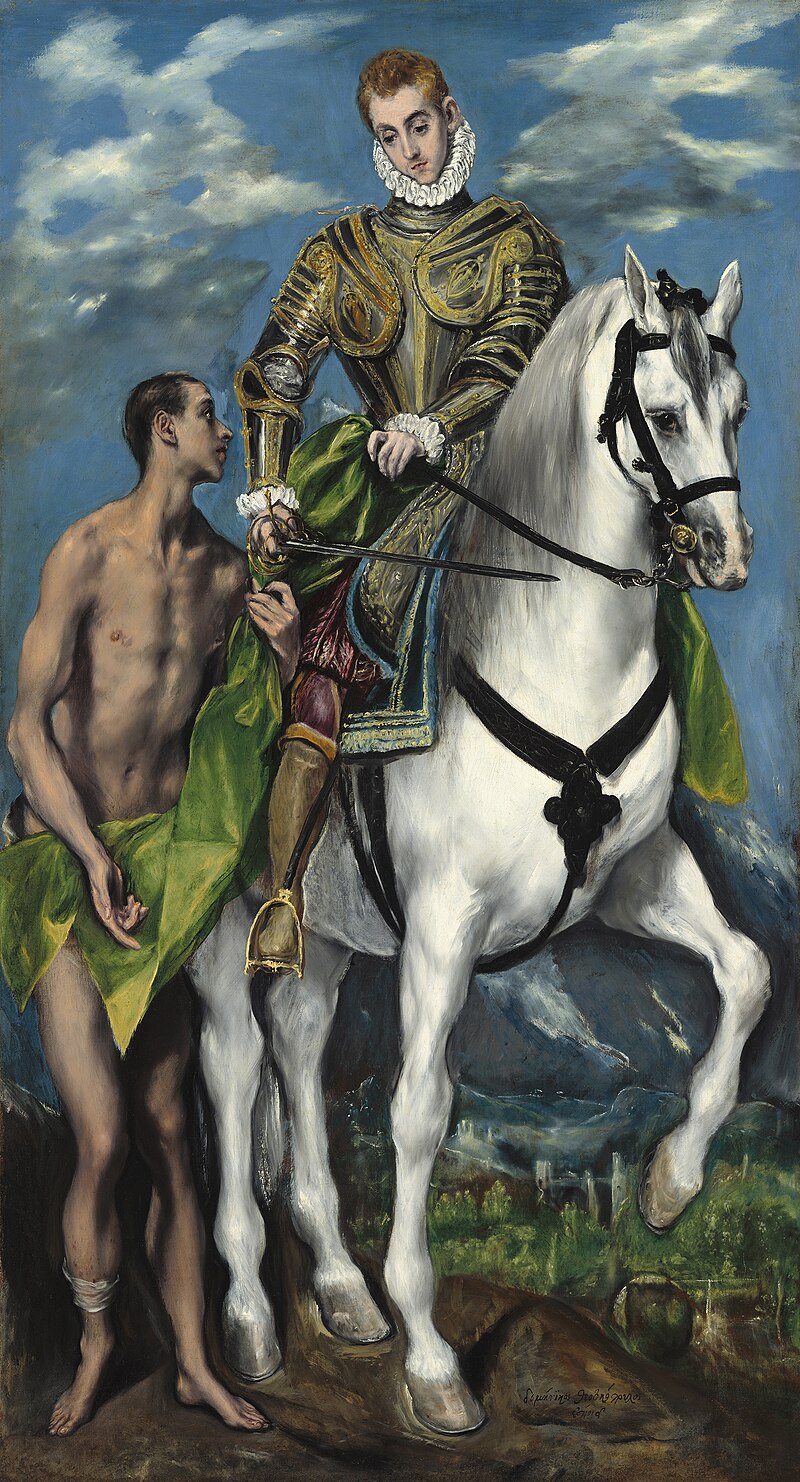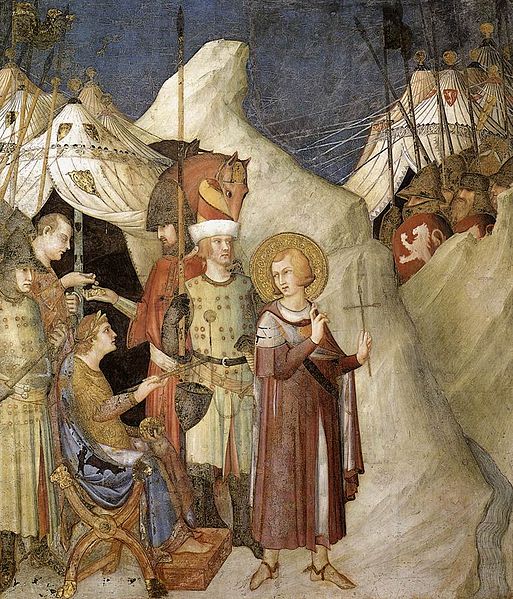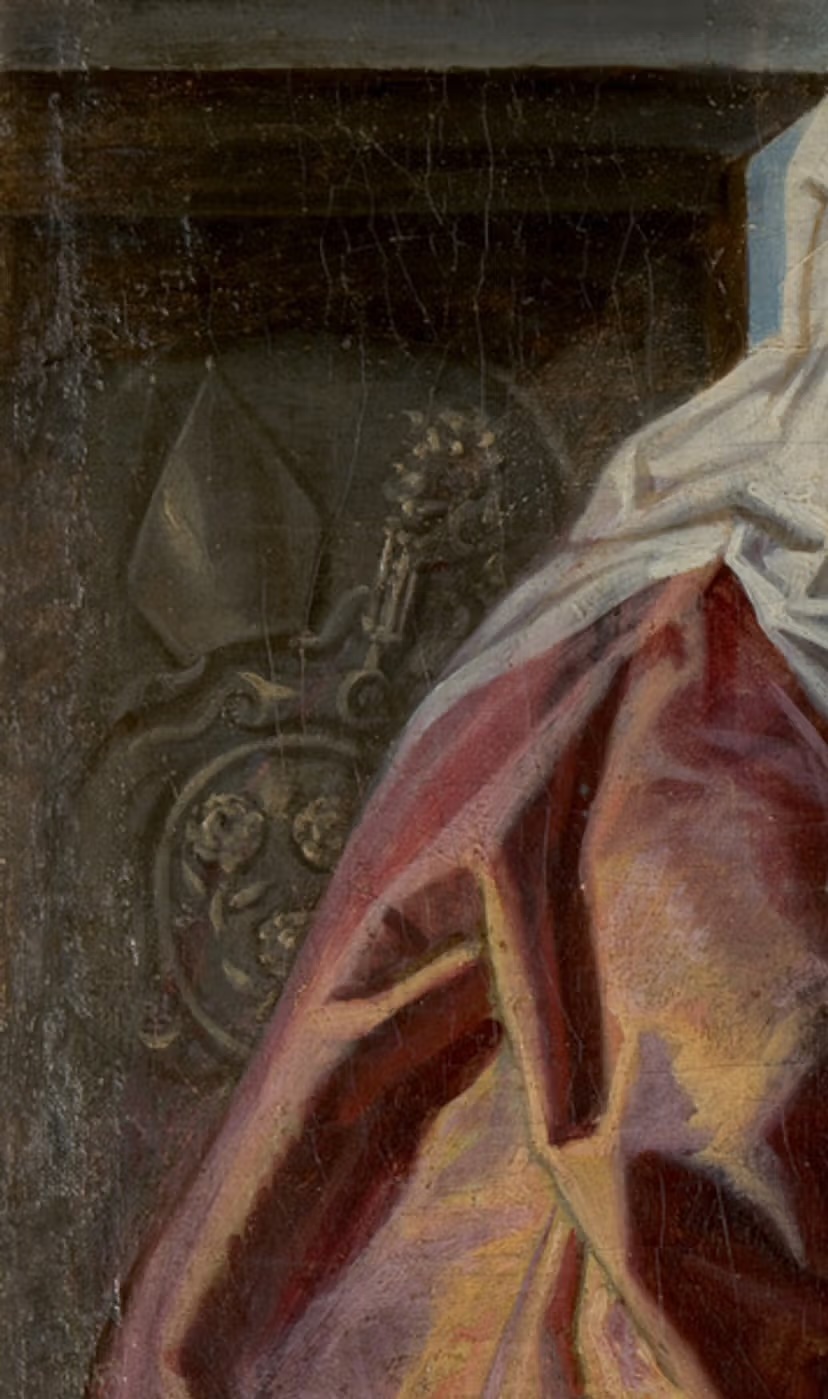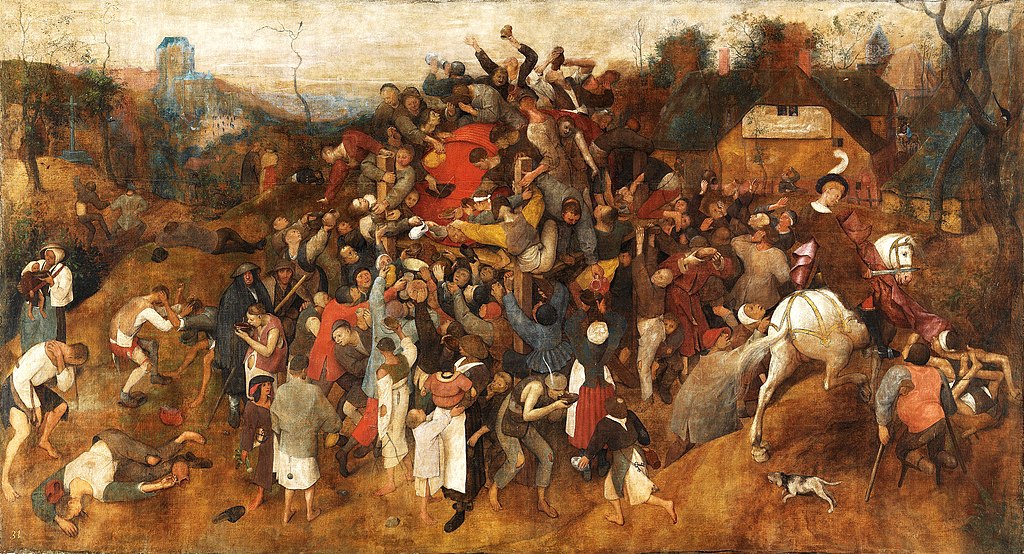
”Saint Martín and the Beggar” (1597-99)
The Feast of St Martin, or Martinmas, is celebrated on November 11. El Greco’s painting “St Martin and the Beggar” (1597-99) (76”x41”) (National Gallery of Art, DC) is a depiction of St Martin of Tours (c.316-397), a member of the Imperial cavalry of the Roman Emperor Constantine the Great. Martin was stationed in Gaul in the French city of Amiens. The story goes that on a cold winter day Martin came across a naked beggar. He took off his warm green wool robe and cut it in half to share with the poor man. That night Martin experienced a vision of Christ wearing the robe, Christ said to him, “What thou hast done for that poor man, thou hast done for me.” Another story tells that when Martin awoke, his cloak had been restored. In the painting, Martin rides a magnificent white Arabian horse, in keeping with his position. He wears black armor decorated with elaborate gold designs in the Damascene style developed by the craftsmen of Toledo, Spain.
El Greco, was born on the island of Crete, off the Greek mainland. He was trained to be a Byzantine Greek icon painter. He later moved to Toledo, Spain, working there for the last 37 years of his life. His Greek name Doménikos Theotokópoulos was hard to pronounce, so he was nicknamed El Greco (the Greek). He continued to paint elongated figures in the Byzantine style to accentuate the spiritual over the physical, apparent in the figure of the beggar. The viewer looks up at the two figures, and they seem monumental. In the background is the city of Toledo and the River Tagus that El Greco often included in paintings at the time. Also typical of El Greco is the use of intense colors and portrayal of a “moody” sky. This painting is considered one of his greatest.

“St Martin Renounces his Weapons (1322-26)
Martin’s father was a senior military officer; thus, Martin was obligated at age 15 to join the army. Martin’s vision encouraged him in his Christian beliefs, and he was baptized at age 18. “St Martin Renounces his Weapons” (1322-26), painted by Simone Martini of Siena, is a depiction of the time when Martin left the army. Young Martin stands before the seated Emperor Constantine. Martin holds a cross. Constantine holds a sword. The setting is in a military camp with elegant tents, members of the Imperial Guard in attendance, and horses set in a rocky landscape.
The painting was commissioned by Robert d’Anjou, King of Naples, to fulfill the last wish of Cardinal Montefiore, who went to Buda, Hungary in 1307 and gained the crown of Hungary for Robert d’Anjou. St Martin was born in Hungary, and Montefiore considered Martin’s aid a significant factor in his success. On returning to his home in Assisi, Montefiore asked that a chapel dedicated to St Martin be built in the church of San Francesco in Assisi. This painting is one of ten depictions of the life of St Martin painted by Martini at Assisi. An early Renaissance artist, Martini and the Sienese artists were beginning to create fully three-dimensional works of art.

”Saint Martin Healing the Possessed Man” (1630)
Martin declared he was a soldier for Christ and became a monk, holy man, and ultimately the Bishop of Tours in 371. The hagiographer (biographer of lives of saints) Sulpicius Severus, knew Martin personally, and described several of Martin’s miracles: raising the dead, healing the sick, exorcism, and others.
“St Martin Healing the Possessed Man” (1630) (48”x34”), painted by Jacob Jordaens (1593-1678), the leading Flemish painter after the deaths of Rubens and Van Dyke, could represent a healing of the sick, or perhaps an exorcism. In the classical Baroque style, Jordaens places Martin on a high porch and dressed as the Bishop of Tours. Below him are a number of persons who appear to have come for his help and his blessing. The naked and apparently possessed man writhes on a lower step. An old man and three women of varying ages look in fear at the figure wearing the gold and blue turban, red robe, and leather boots, and drawing his sword. Is he evil, perhaps a devil, or is he the executioner if the possessed man cannot be cured? He is the only figure in foreign dress. The setting is a compilation of gilded capitals, marble columns, and arches. Jordaens leaves the viewer confused about the setting and the cast of characters. He does present a solid and masterful image of St Mark.

‘Saint Martin Healing the Possessed Man” (detail)
During restoration an overpainted coat of arms was discovered at the base of the column. The coat of arms belonged to Antonius de Rorre, a Benedictine abbot, most likely the patron for this painting, the first Jordaens altarpiece. Jordaens would continue to grow as an artist as did his reputation as the successor of Rubens and Van Dyke.

“The Death of St Martin of Tours” (1490)
St Martin foresaw his death, and it is recorded that he said, “Allow me, my brethren, to look rather towards heaven than upon the earth, that my soul may be directed to take its flight to the Lord to whom it is going.” “The Death of St Martin of Tours” (1490) was painted by German artist Derik Baegert (1440-c.1515). Although St Martin was born in c. 316 and died on November 8, 397 CE, at the age of eighty-one, he is depicted as a young man. Wearing a red robe, St Martin lies on a coffin covered by woven straw mat. He is mourned by a kneeling angel and four men. One with glasses reads from a scroll, the second reads from the Bible and sprinkles him with holy water, and a third prays. The elderly man kneeling in the front holds a gold candle that symbolically will light St Martins way to Heaven. Outside the windows is a Germanic landscape, and God receives the naked bodies of the faithful. The two-headed devil gesticulates at the foot of the coffin. St Martin reportedly stated, “Why are you standing here, cruel beast? You shall find no cause for grief in me!”

“Wine on St Martin’s Day” (1566-68)
Martin was called a Saint by popular acclaim in the Fifth and Sixth Centuries, before he was actually canonized. In the Middle Ages, Catholics began a forty-day fast on November 12, the day after St Martin’s Feast Day. The period of fasting was called Martinmas, the spiritual preparation for Christmas. The harvest season had ended and the slaughtering of livestock, particularly cattle and pigs, for winter began on November 12 in Europe. Sausage and black pudding known as “Pig cheer” were gifts. Two popular dishes were Martinmas beef and Martinmas goose. When Martin tried to hide from those who wanted him to be the Bishop of Tours, he chose a barn housing a flock of geese. Their honking alerted his trackers, and he was forced to take the job. The goose is one of Martin’s symbols.
In many European countries Martinmas began with the lighting of bonfires or candle-light processions. A member of the community would dress as St Martin and ride on horseback distributing gifts. The ashes from the fires then might be spread on the ground as fertilizer. Another feature of Martinmas was drinking the first wine of the season. “Wine on St Martin’s Day” (1566-68) is by Pieter Brueghel the Elder (c.1525/30-1569), one of the best-known painters of landscape and genre scenes in the Netherlands. It is his largest painting (3’10’’ by 8’10’’). The celebrating villagers are composed in a triangular mass that leads up to a large red barrel of wine. Typical of Brueghel’s paintings, peasants of all ages and types drink, eat, dance, brawl and otherwise celebrate the day. Astride his white horse, St Martin cuts his red cloak in half to give it to two crippled beggars. Brueghel is known for including the poor and disabled in his paintings. The whole scene takes place outside a local village. Houses and a church tower are placed at the right side of the scene. In the distance at the left are a large town with more substantial buildings and towers. They are the homes of the wealthy, but they are not here in this merry scramble of peasants.
St Martin was the patron saint of beggars, wool-weavers, and tailors, to name a few. Although opposed to violence, he was made patron saint of the US Army Quartermaster Corp. It considered Martin to be a role model for soldiers because of his military service, compassion, and selflessness. On February 7, 1997, the Quartermasters Corp established the military Order of St Martin. Armistice Day (now Veterans Day) marks the day of the ceasefire that ended World War I at the 11th hour on the 11th day of the 11th month.
Beverly Hall Smith was a professor of art history for 40 years. Since retiring to Chestertown with her husband Kurt in 2014, she has taught art history classes at WC-ALL and the Institute of Adult Learning, Centreville. An artist, she sometimes exhibits work at River Arts. She also paints sets for the Garfield Theater in Chestertown.




Write a Letter to the Editor on this Article
We encourage readers to offer their point of view on this article by submitting the following form. Editing is sometimes necessary and is done at the discretion of the editorial staff.